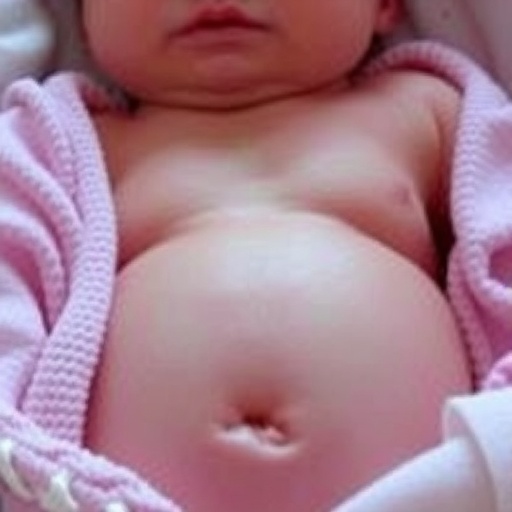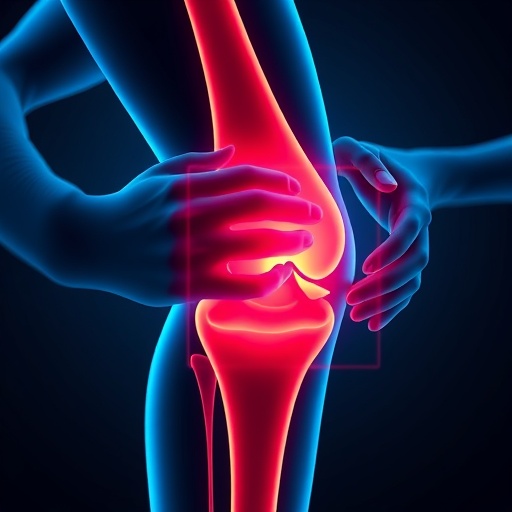
In a groundbreaking new study, researchers have delved deep into the complex interplay between infection epidemiology and antibiotic utilization among newborns diagnosed with congenital diaphragmatic hernia (CDH), shining light on an area long shrouded in clinical uncertainty. CDH, a severe birth defect characterized by a malformation of the diaphragm, poses critical challenges not only due to the anatomical complications but also because of the heightened vulnerability of affected newborns to infectious agents. This vulnerability often leads to extensive antibiotic usage, but until now, the patterns and implications of such medical practices were poorly understood on a large scale.
The study, recently published in the Journal of Perinatology, represents one of the most comprehensive epidemiological investigations into infection exposure and antibiotic treatment among neonates with CDH. Spearheaded by S.J. Flohr and colleagues, this research utilized an extensive cohort, employing meticulous data collection that spanned multiple institutions to capture a holistic picture of infection trends and antimicrobial interventions in this fragile patient population. The results not only underscore the complexity of managing infections in CDH newborns but also highlight the urgent need for refined therapeutic protocols tailored to their unique immunological and physiological profiles.
Congenital diaphragmatic hernia impacts the delicate balance of neonates’ respiratory and gastrointestinal function, often necessitating immediate surgical correction and intensive supportive care. However, the innate vulnerability of these newborns, characterized by compromised pulmonary development and frequent invasive procedures, predisposes them to a spectrum of infections ranging from early-onset sepsis to late nosocomial pathogen colonization. Within this clinical backdrop, antibiotic exposure becomes almost inevitable yet remains a double-edged sword. The study carefully quantifies how such exposure correlates with infection rates, antibiotic resistance emergence, and long-term outcomes.
.adsslot_ULGmR6NFhx{width:728px !important;height:90px !important;}
@media(max-width:1199px){ .adsslot_ULGmR6NFhx{width:468px !important;height:60px !important;}
}
@media(max-width:767px){ .adsslot_ULGmR6NFhx{width:320px !important;height:50px !important;}
}
ADVERTISEMENT
One of the key findings of the research pertains to the timeline and nature of infections in CDH newborns. The authors reveal a nuanced infection chronology, with early infections primarily driven by vertical transmission or immediate postnatal environmental exposure, thus implicating perinatal management strategies as critical determinants of infection risk. Contrastingly, late infections tend to reflect hospital-acquired pathogens, underscoring the significance of infection control policies within neonatal intensive care units (NICUs). The differentiation between early and late infections informs clinicians about the timing of prophylactic antibiotic use, a topic that elicits considerable debate.
Antibiotic stewardship emerges as a central theme throughout the study. While empirical antibiotic therapy is common practice in the face of suspected infections, indiscriminate use can escalate the risk of antibiotic resistance and disturb the neonate’s developing microbiome. Flohr and colleagues raise pertinent concerns about the balance between adequately treating potential infections and minimizing unnecessary antibiotic exposure. Their epidemiological analysis meticulously documents antibiotic regimens, revealing wide variability in the choice, duration, and intensity of treatment across centers, thereby calling attention to the need for standardized guidelines that can optimize therapeutic outcomes without exacerbating resistance issues.
Technological advancements have enabled the team to leverage state-of-the-art diagnostic tools, combining traditional microbiological cultures with advanced molecular techniques for pathogen identification. This comprehensive approach allowed more accurate delimitation of infectious events and challenged some previously held assumptions about the prevalence and diversity of microbial agents affecting CDH patients. The detection of unexpected viral and fungal pathogens alongside bacteria alters the clinical understanding of infection etiology in this population, indicating the need for broader diagnostic consideration in NICU settings.
Beyond immediate infectious risks, the study explores how antibiotic exposure itself modulates neonatal immune responses. Prolonged or repeated antibiotic courses appear to influence the neonates’ inflammatory profiles and susceptibility to subsequent infections. These findings suggest an immune dysregulation scenario, where the treatment aimed at controlling infections paradoxically predisposes newborns to additional infectious insults or immunological challenges. The authors advocate for further research into immunomodulatory therapies that might complement or replace traditional antibiotic approaches in certain clinical contexts.
Moreover, the research touches upon the long-term implications of antibiotic usage in CDH survivors. Although the neonatal period is critical, the early inflammatory and antimicrobial exposure can have lasting impacts on microbial colonization patterns, allergic sensitization, and chronic respiratory morbidity. By integrating clinical follow-up data, the study provides preliminary evidence linking neonatal antibiotic regimens with developmental trajectories and host-microbiome interactions, emphasizing the profound interconnectedness of early medical management and overall health outcomes.
Another layer of complexity is introduced by the heterogeneity of CDH presentations and associated anomalies. The researchers underscore that infection susceptibility and antibiotic responses are not uniform but instead influenced by factors such as defect size, presence of pulmonary hypertension, and the institution’s clinical protocols. This highlights the importance of individualized care pathways and the potential benefits of predictive models incorporating epidemiological and clinical variables to formulate personalized infection prevention and treatment strategies.
Preventive strategies against infection, gleaned from the epidemiological data, suggest a multipronged approach. Enhancing maternal health and perinatal infection surveillance could reduce early-onset infections, while reinforcing NICU hygiene and cohorting policies may mitigate late infections. The study’s detailed mapping of pathogen prevalence provides a critical resource for optimizing prophylactic antibiotic selection and developing targeted antimicrobial stewardship programs that align with real-world microbial threats encountered in the CDH population.
The authors also advocate collaboration across institutions to facilitate large-scale data sharing, enabling continuous refinement of infection control practices and antibiotic use guidelines. The study sets a precedent for the integration of epidemiological surveillance within newborn surgical care, fostering a learning health system that adapts to emerging resistance patterns and evolving microbial landscapes. Such efforts are pivotal in bridging the gap between bench research and bedside application, ultimately improving survival rates and quality of life for infants suffering from CDH.
Importantly, the study emphasizes that antibiotic stewardship is not just a clinical imperative but an ethical obligation in neonatal care. By balancing the urgency to treat life-threatening infections against the risks of overuse, clinicians can safeguard both individual patients and public health at large. The nuanced insights presented challenge current paradigms and call for dynamic, evidence-based protocols that can be tailored to the specific vulnerabilities inherent to CDH newborns.
This landmark investigation by Flohr et al. ultimately advances our understanding of infection dynamics and antibiotic utilization in a uniquely vulnerable but understudied neonatal population. Through its rigor and scope, the research charts a path toward safer, more effective infection management strategies that may serve as a model for other complex congenital conditions. As neonatal intensive care continues to evolve, such epidemiological insights will be indispensable in optimizing care for our most fragile patients.
By dissecting the epidemiological foundations of infection and treatment in CDH, this study lays critical groundwork for enhanced clinical decision-making and future therapeutic innovation. The findings not only guide immediate clinical practice but also open avenues for translational research into immune modulation, novel antimicrobial agents, and non-antibiotic infection control measures. The study exemplifies the power of interdisciplinary, data-driven approaches to tackling some of neonatology’s most daunting challenges.
In summary, the investigation into antibiotic exposure and infection epidemiology among newborns with congenital diaphragmatic hernia addresses a pivotal gap in neonatal care knowledge. Through comprehensive cohort analysis, the authors elucidate infection timing, pathogen diversity, antibiotic usage patterns, immune impact, and long-term consequences, providing a multifaceted view essential for advancing clinical practice. As the study gains attention within the medical community and beyond, it promises to catalyze improvements in neonatal infection management worldwide, benefitting countless infants and their families.
Subject of Research: Infection epidemiology and antibiotic utilization among newborns with congenital diaphragmatic hernia (CDH).
Article Title: Antibiotic exposure and infection epidemiology among newborns with congenital diaphragmatic hernia.
Article References:
Flohr, S.J., Mathew, L., Hedrick, H.L. et al. Antibiotic exposure and infection epidemiology among newborns with congenital diaphragmatic hernia.
J Perinatol (2025). https://doi.org/10.1038/s41372-025-02389-9
Image Credits: AI Generated
DOI: https://doi.org/10.1038/s41372-025-02389-9
Tags: Antibiotic use in newbornsAntimicrobial intervention patternsClinical implications of CDH treatmentComprehensive epidemiological investigationsCongenital diaphragmatic hernia researchData collection in pediatric studiesInfection epidemiology in neonatesJournal of Perinatology study findingsNeonatal infection management strategiesRespiratory complications in CDHTherapeutic protocols for CDHVulnerability of newborns to infections





